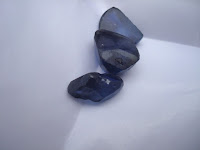An Overview Of The Effect Of Heat On Inclusions In Corundum
The Ancient Story of Heat
Articles of adornment ( gems) have been used by human beings at least from about 7000 years back and by its very definition, these are items of a comparative rarity to have served this need. So it is not difficult to imagine that attempts were made to imitate, falsify or enhance these gems to meet demand.
To quote Pliny, the Greek philosopher (23AD to 79AD) “ there is no fraud or deceit in the world which yields greater gain and profit than that of counterfeiting gems “
Max Bauer in his book Edelsteinkunde of 1896 states that Sapphires were heated to make them lighter and that rubies of uneven colour may have the colour evened by heating.
It is not difficult to assume that during various conquests slaves going through the charred remains on the battlefields would have come across partially cooked gems of their masters ( only rulers and priests were allowed to wear jeweler in those times). These finds would have been recorded, and when the news passed down to the artisans, they would have quietly experimented with gems given to them for mounting by their masters. Of course, if they failed they would pay for their mistakes with their life.
Applications of heat treatment
- To remove or lessen blue component in rubies
- To create or intensify blue in sapphires (Geuda)
- To lighten blue colour in sapphires (Kashmir, Australian, Pailin )
- To remove green or change green to blue-green or blue in sapphires
- To intensify yellow in sapphires
- To heal fractures
- To induce asterism in corundum
- To diminish Verneuil banding and strain
- To remove or lessen Blue component
Now fast track to the twentieth century. At least from the early 1900`s rubies were heated with blow –pipes at about 300 degrees ( Celsius) to rid them of the slight blue tones that gave them the less desirable overall purple
This treatment left most of the inclusions intact except the carbon –dioxide gas bubbles inside some crystals. Heating at these temperatures is very often impossible to detect -
- To create or intensify blue in sapphires
Geuda is simply a corundum tightly packed with exsolved titanium thus making it near opaque. Of course the degree of opaqueness varies.-
Since pure corundum is Al2O3 and is colourless the colour in Corundums is caused either by a) impurities as trace elements e.g. Cr2 causing red and pink and Ti4 and Fe3 causing Blue or b ) due to colour centres caused by lattice defects such as a missing Al or O ions or an extra Al or O ion or charge carriers such as extra electrons. Heat treatment is simply a process by which one or all of the above effects are caused. –
Geuda is treated from anything starting from 1000 degrees to 1700 degrees. As we all know heat causes all substances to expand and the effects of such expansion can be seen in the inclusions in sapphires too.
Another effect of heat treatment on crystals is that some of them melt and on cooling they become glass due to rapid cooling. Since the glass is lower in volume than the crystal, the spaces thus caused entrap gas bubbles.
As the temperature increases very high, the rutile needles dissolve completely or get reduced to fine pinpoints which are readily observed under magnification -
- To lighten dark blues
Heat treatment has been applied to lighten the “inky” Australian, Pailin and it is suspected that even the lower qualities of the most coveted Kashmir blues.
These stones are heated at the rate of about 5 degrees per min. Until 1700 was reached and maintained for about 5 hours. This would result in an overall lighter blue sometimes with white patchy areas. Some of the inclusions would undergo dramatic changes
- To remove Green from Sapphires
Green Sapphires from Australia And Thailand are heated at temperatures of about 1600 to 1800 to remove the green. This is a process by which the silk is burned off
- To intensify Yellow in Sapphires
Stones are heated in an oxidizing atmosphere at about 1600 – 1800. This causes an outward diffusion of colour causing agents from exsolved particles thus giving the gems an intense yellow colour.
- To heal fractures -
Fractures in many Sapphires and rubies were healed by heating in flux.
- To induce asterism
When Sapphires containing a considerable amount of titanium oxide cools rapidly in nature the material; will be clear and the titanium is in “ solid solution” in the form of Ti2O3 ( titanium sesquioxide). If this material is heated to about 1300 degrees and kept for about 24 hrs. Titanium oxide or rutile needles are formed giving rise to asterism.
- Very long heating at 1600 of Verneuil synthetics can cause the slow diffusion inside these stones to even out the irregularities in growth structures which caused the curved lines thus making them less prominent.
Sheriff Abdul Rahuman
Gemmologist, DGemG (Germany ), MGA ( Sri Lanka )
GIA Alumni


No comments:
Post a Comment